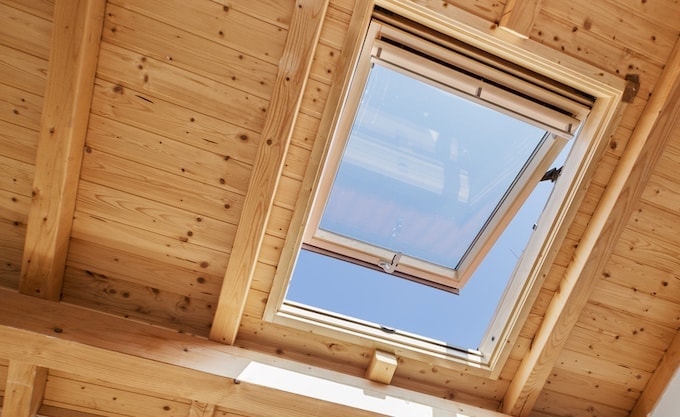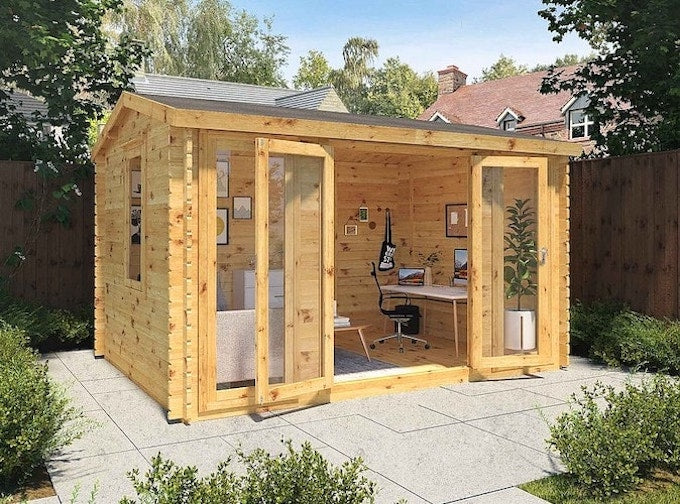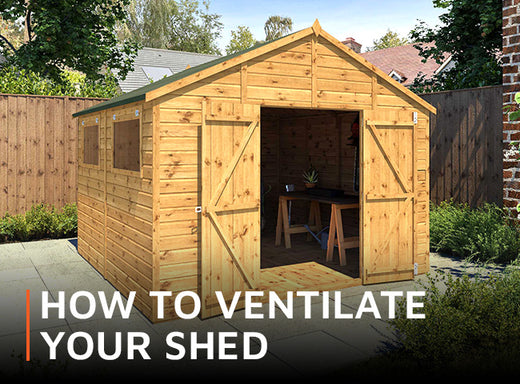Shed ventilation is one of the best ways to look after your garden building. If it’s baking hot in summer, freezing during the winter and always damp, you’re unlikely to get the most from the space. What’s more, your shed won’t last as long, and your belongings could get mouldy or rusty as well.
You’ll know your shed has problem humidity levels if there’s a musty smell, condensation-ridden windows and warped wood. The good news is that a few simple ventilation techniques can help to keep extremes of temperature and damp under control. Here’s how to ventilate your garden shed so it’s a comfortable place to be.
Shed ventilation tips, at a glance:
- Open doors and windows regularly
- Install high-level mesh-backed vents on each gable wall to improve airflow
- Install ridge/roof vents to allow hot air to escape
- Treat your shed’s interior to prevent it from absorbing moisture
- Keep your vents clean to prevent blockage
- Install shed roof windows (rooflights)
- Invest in a whirligig
- Fit an electric fan
How to ventilate a small wooden shed

You can check your shed’s humidity level (the air’s water content) with a hygrometer, and if it’s showing at more than 60%, you should check your ventilation.
Make sure there's adequate airflow to ensure better temperature control and a drier atmosphere, which helps protect tools, electrical equipment and garden chemicals from damage. Here are five simple ways to reduce humidity and encourage better airflow:
- Open doors and windows regularly
- Install mesh-backed vents high up on each gable wall
- Install ridge vents or roof vents
- Treat your shed’s interior
- Keep your vents cleaned and maintained
The easiest way to keep a shed ventilated is to regularly open doors and (if you have them) windows so that air circulates often and easily. If your shed is left closed for long periods, then you may want to consider options to prevent damp taking hold.
If you’re installing a new shed, give thought to the most common wind direction when deciding where to erect it. Siting your shed so the prevailing airstream hits the gable end is best. By installing two vents, one high up on each gable wall, you’re guaranteed a healthy throughflow of air. Make sure the vents you install are mesh-backed to prevent bugs making a home in your shed. These two small ventilation grilles on opposite walls will provide good air flow.
If you have an apex roof, install ridge vents on the peak to let hot air out of the building. For pent roofs, roof vents might be more suitable. Made of tough, opaque plastic, like a caravan roof vent, these help the air to circulate and fumes from paint or petrol to escape, while a grille keeps creepy crawlies out. Ideal for windowless sheds, they’re lightweight and easy to install.
Treating the inside of your garden building with a waterproof paint or treatment will ensure it doesn’t absorb lots of moisture during damp periods, only to release it back into the air when it’s drier – causing prolonged dampness. You could even consider a waterproof membrane on your shed walls.
It’s vital that any airflow you set up is kept clear – if airways are blocked, air won’t circulate, and moisture won’t be carried outside, resulting in the return of damp.
How to ventilate large wooden sheds and workshops
A larger shed, log cabin or summer house may need a bit more help to stay well-ventilated, especially if you like to spend lots of time in it. Workshops or craft rooms where paints and chemicals are used may also benefit from additional ventilation.
If you’ve tried the methods outlined above, or you have a building with a footprint of over about 175 square feet (the size of a small to medium workshop), here are three more ways to keep your building comfortable, safe and well-maintained:
1: Install shed roof windows (rooflights)

If you have the budget and the inclination, go one better by putting in roof windows you can open and close. Skylights are a great option if you use your shed as a workshop because they make it so much easier to cool the temperature on warm days. By also installing wall vents or leaving the door ajar, hot air rising through open skylights draws cooler air into the building from outside. On cold, clear winter days, windows in your roof maximise warmth from the sun.
2: Invest in a whirligig

Image: SantaGig/Shutterstock
We often see whirligigs installed on van roofs – the wind pushes a turbine around, which draws air up and out of the vehicle. Wind powered shed vents are larger than their automotive equivalents, but they work in exactly the same way.
Install your whirligig according to the manufacturer’s instructions, but generally, these ventilation units work best when they’re sited near the apex of the roof, in a central location. Check to make sure that you know where your roof battens are before you cut the hole, so that you don’t damage the structure of the building.
As with all roof-mounted vents, a whirligig works much more effectively if it’s complemented by gable wall-mounted static vents – to move air through the building, it has to be able to find a way in as well as out.
3: Fit an electric fan

To avoid sweltering on hot, windless days, install a solar or mains powered electric fan. Mount this in one gable wall, make sure there’s a static vent in the opposite wall, and switch on whenever you need a draught. This solution is ideal for times when you’re mixing paint, or using solvents or petrol.
Special ventilation solutions for garden offices

If you're using your shed as an garden office or workroom, it’s vital to get the right balance of temperature and humidity control, especially if you’re using the space to house delicate IT equipment. Static vents are a must to let air into and out of the building, but you’ll also need some sort of temperature regulation.
A great way to combine heating and cooling is to install an air source heat pump, provided your ventilation is already in place. This works a bit like a fridge that can be reversed to pump cool air on hot days and warm air on cold days. Cheap to run, air source heat pumps are an excellent way to keep the temperature in your shed stable.
Another popular method is to either install a permanent electric air conditioner, or to use a portable and cost-effective unit that you can bring into your house when it’s not being used to heat or cool your garden office.
Effective ventilation means you’ll be able to make so much more of your shed. If you’re considering turning the space into a she-shed, man cave, workshop or craft room, or if you just want to be able to store your tools in your shed without them corroding, you now have the knowledge to get your ventilation sorted.
MORE HELP
Visit the Waltons help pages or the Waltons garden building how-to guides for advice, tips, and all things sheddie.
Lead image: 10 x 10 Premium Shiplap Apex Wooden Workshop from Waltons



Share:
How to damp-proof your shed
How to insure your shed